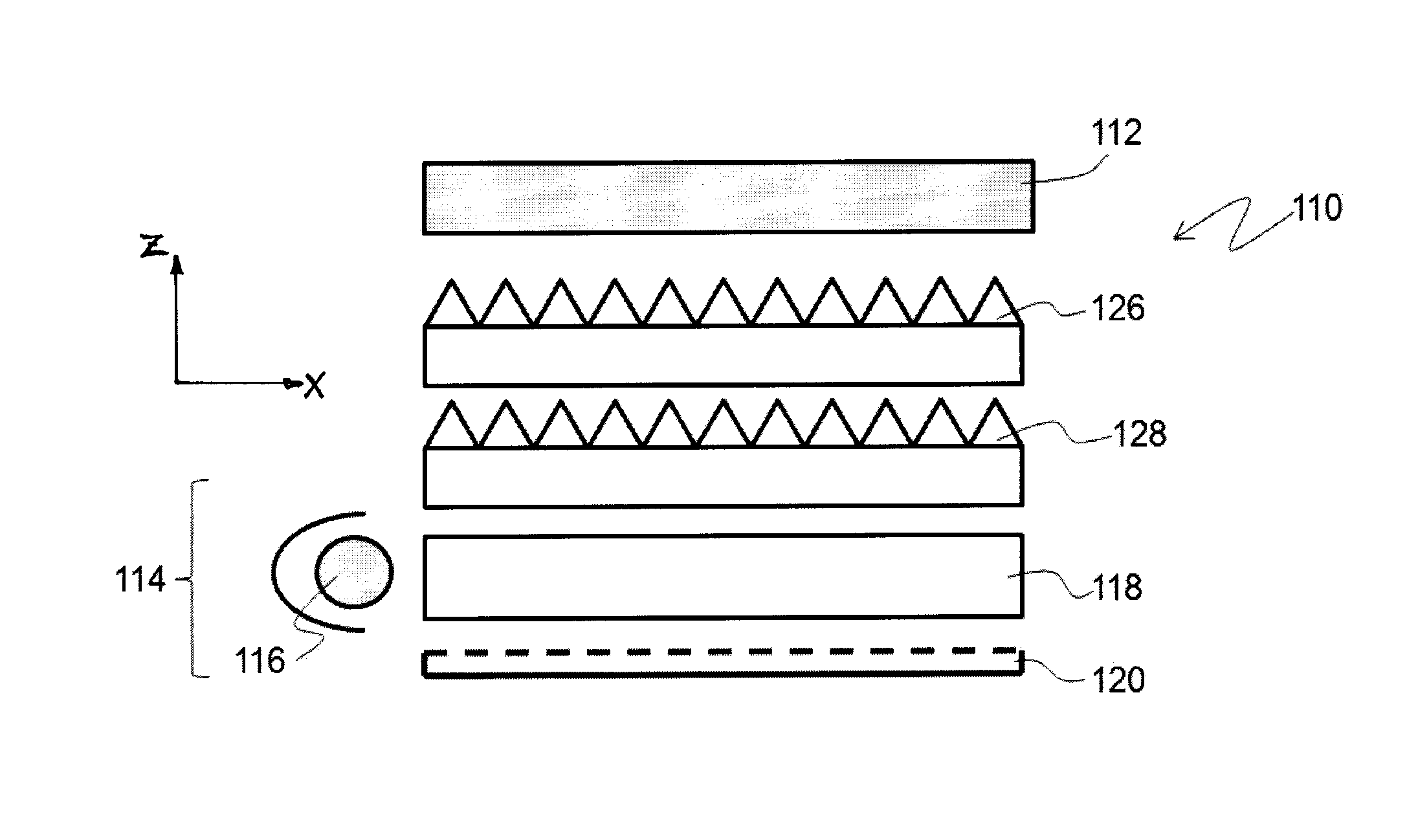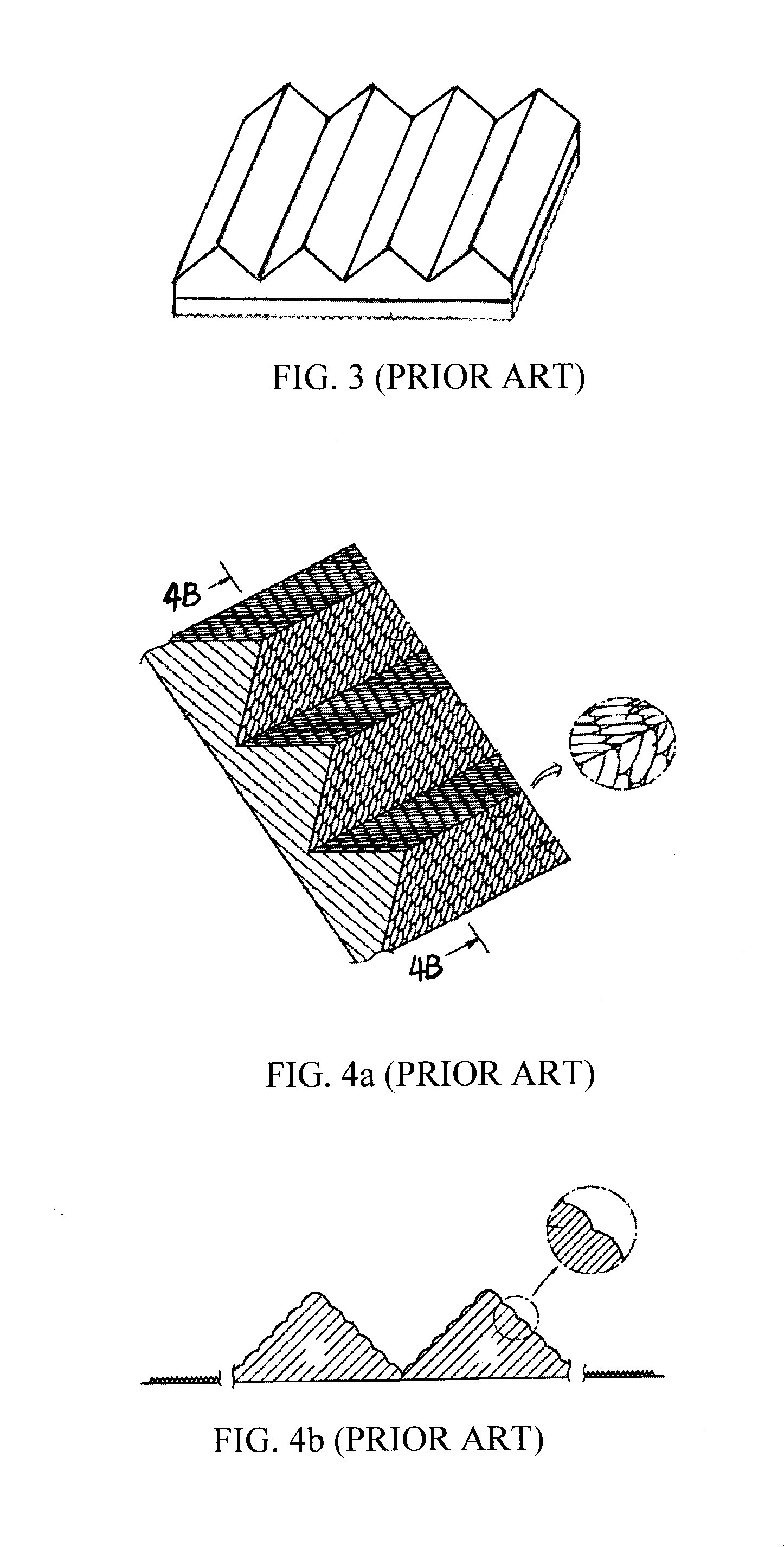Optical substrates having light collimating and diffusion structures
a technology of optical substrates and structures, applied in the direction of instruments, lenses, other domestic objects, etc., can solve the problems of less effective light directing, less light scattering, and invisible to the user, so as to achieve the effect of increasing the overall brightness of lcd, and not reducing the overall brightness of the light transmitted through the lenticular surfa
- Summary
- Abstract
- Description
- Claims
- Application Information
AI Technical Summary
Benefits of technology
Problems solved by technology
Method used
Image
Examples
experiment a
[0123]Table 1 shows the effects of the angle θ of the lenticular structure (e.g., similar to embodiment shown in FIG. 6a, with flat ratio at 0%) on gain and diffusion / haze. It has been observed that interference fringes are eliminated and the gain maintained between 1.49 and 1.54 for angle θ in the range of 16 degrees to 66 degrees.
TABLE 1Haze(single sideGainlenticular(with prismstructurestructurewith noon theLenticular structureFlatprismlight RadiusAngle θRefractiveAngle αratiostructure)outputDark and bright(μm)(deg.)Index(deg.)%%side)fringes60061.489002.381.55Observed600161.4890020.251.54Observed600261.4890042.921.53Very slight58361.4890058.041.53Not observed600461.4890065.61.51Not observed600561.4890070.831.49Not observed58661.4890072.91.51Not observed58821.4890078.241.42Not observed581061.4890079.091.25Not observed581201.4890081.011.23Not observed581441.48900 81.181.20Not observed
experiment b
[0124]Table 2 shows the effects of the refractive index of the lenticular structure (e.g., structure shown in FIGS. 6a and 8 with zero flat ratio). At bigger angles θ, haze is higher but gain is lower. Haze will increase when the refractive index of lenticular structure increases. However, the gain of optical substrate will decrease. It appears that the preferred refractive index of lenticular structure is in the range of 1.45 to 1.58.
TABLE 2Haze(single sideGain lenticular(with prismstructurestructurewith noon theLenticular structureFlatprismlight RadiusAngle θRefractive Angle αratiostructure)outputDark and bright(μm)(deg.)Index(deg.)%%side)fringes58821.5690087.21.34Not observed58661.5690075.71.48Not observed58521.5690071.81.51Not observed58361.5690063.01.51Not observed58821.4890078.21.42Not observed58661.4890072.91.51Not observed58 521.4890068.41.53Not observed58 361.4890 058.01.53Not observed
experiment c
[0125]Table 3 shows there is no significant change in haze and gain while changing lenticular radius (e.g., structure shown in FIGS. 6a and 8 with zero flat ratio). However, angle θ is significant to changes in haze and gain.
TABLE 3Haze(single sideGain lenticular(with prismstructurestructure with noon the Lenticular structureFlatprismlightRadiusAngle θRefractive Angle αratiostructure)output Dark and bright(μm)(deg.)Index(deg.)%%side)fringes7.81061.4890077.21.35Not observed231061.4890081.51.34Not observed581061.4890079.11.25Not observed7.8661.4890070.51.51Not observed23661.4890070.01.51Not observed58661.4890072.91.51Not observed7.8361.4890029.31.55observed23361.4890050.91.54Not observed58361.4890058.01.53Not observed
PUM
| Property | Measurement | Unit |
|---|---|---|
| Width | aaaaa | aaaaa |
| Surface area | aaaaa | aaaaa |
Abstract
Description
Claims
Application Information
 Login to View More
Login to View More - R&D
- Intellectual Property
- Life Sciences
- Materials
- Tech Scout
- Unparalleled Data Quality
- Higher Quality Content
- 60% Fewer Hallucinations
Browse by: Latest US Patents, China's latest patents, Technical Efficacy Thesaurus, Application Domain, Technology Topic, Popular Technical Reports.
© 2025 PatSnap. All rights reserved.Legal|Privacy policy|Modern Slavery Act Transparency Statement|Sitemap|About US| Contact US: help@patsnap.com



